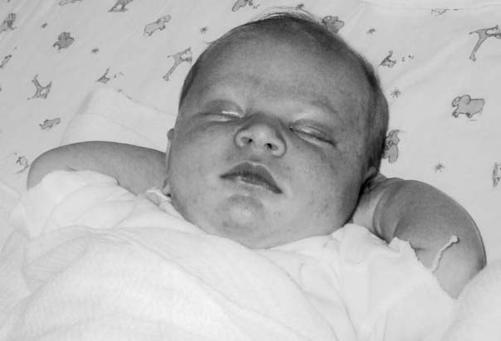The No-cry Sleep Solution (14 page)
Read The No-cry Sleep Solution Online
Authors: Elizabeth Pantley



1
Do a Safety Check
Because you haven’t had quality sleep since before pregnancy or since your new baby entered your life, you may feel that nothing is more important right now than getting a full night’s sleep. But there is indeed something much more important than sleep: your baby’s safety. So it’s critical that we start there.
In their quest for a few more minutes of shut-eye, well-intentioned, but sleep-deprived parents make mistakes. I have heard and read about many situations in which parents put their babies in unsafe situations, all in the name of a few hours of sleep. Here are a few of those stories. I’ve listed only those with happy endings—but sadly, many other stories end differently.
• Parents of a newborn knew they shouldn’t have their fluffy quilt in bed with the baby, but they were cold without it.
One night, the mother woke to find that her baby had bur-rowed under the heavy quilt.
• One baby’s mother was so elated when her baby fell asleep on the sofa that she left him there to nap while she went to work at her computer. A loud thump had her running to the family room where she found her baby crying on the floor.
• A mother with a baby who refused to nap admitted that when her baby fell asleep in the car seat, she left her to sleep in the garage while she went in to make dinner. She didn’t want to risk waking her up by moving her to her crib.
27
Copyright 2002 by Better Beginnings, Inc. Click Here for Terms of Use.

28
The No-Cry Sleep Solution
• Parents of a baby boy received a beautiful antique crib with an ornate headboard from relatives. They’d intended to investigate the safety features of the crib but hadn’t gotten around to it. One night, their screaming baby woke them.
They ran quickly to his room and found him wedged
between the headboard and the mattress.
Many of the safety mistakes that parents make are because of poor decisions, while others are because of a lack of knowledge.
You need to know a lot when it comes to your baby’s safety. In this important chapter, you’ll learn the need-to-know things about your baby’s sleep-related safety.
Safety First
Yes, you’re tired, too tired perhaps to read through the vast body of information, research, and guidelines out there on the subject of safety. Maybe you’ll get to it soon, but your good intentions are not enough to keep your baby safe, and you need this information right now.
No matter how tired you are, no matter how tempting the situation
seems, please be sure that you put your baby’s safety above all else.
I’ve gathered safety information from a wide variety of reputable sources and authorities, including the Consumer Product Safety Commission (CPSC), the American Academy of Pediatrics (AAP), the Sudden Infant Death Syndrome Alliance, the National Institute of Child Health and Human Development, and the Foundation for the Study of Infant Deaths. And from all this, I have created sleeping-safety checklists for your review. Please read this brief section, and give it serious consideration.
Keep in mind that these lists cover safety issues relating to
sleep
at
home
. You should, of course, be aware of many other safety issues—at home and away. Also, because safety precautions are

Do a Safety Check
29
updated constantly—and because all babies (and their families) are different—no checklist is fully complete and appropriate for every child. I ask that you please talk with your pediatrician about your particular baby. Do your homework, and please, put safety first.
The Foremost Safety Worry: SIDS
Sudden Infant Death Syndrome (SIDS) is one of the main safety concerns of all parents of babies. SIDS is the sudden and unex-plained death of an infant younger than one year old. SIDS, sometimes known as crib death, is a major cause of death in babies from one month to one year of age. Most SIDS deaths occur when a baby is between one and four months old. The death is sudden and unpredictable; in most cases, the baby seems healthy. Death occurs quickly, usually during sleep. After thirty years of research, scientists still cannot find a definite cause or set of causes for SIDS
or a way to predict or prevent it. But research has uncovered some factors that appear to reduce the risk, which I have incorporated into the safety information and lists that follow. (This information about SIDS is from the U.S. Public Health Service, American Academy of Pediatrics, SIDS Alliance, and Association of SIDS and Infant Mortality Programs, SIDS “Back to Sleep” Campaign.)
Back to Sleep
Many babies may sleep better and longer on their tummies. However, a number of studies have scientifically proved that babies who sleep on their tummies are more susceptible to SIDS. This is a statistical percentage meaning that not every baby who sleeps on her tummy will die of SIDS, and avoiding tummy sleeping is not a 100 percent guarantee against it. Nevertheless, it is the most


30
The No-Cry Sleep Solution
Zoey, three weeks
important recommendation for you to know about. While a few babies actually benefit from tummy sleeping, back sleeping is safest for most. You’ll need to talk with your pediatrician about your particular baby.
Several theories support the back-to-sleep recommendation.
One is that some babies who die of SIDS fall into a deep sleep and do not raise their heads to get oxygen. The other theory is that pressure on a tiny baby’s chest compresses his diaphragm, preventing him from taking sufficiently full breaths. Regardless of the reason, the fact remains that, with all of the unknowns surround-ing SIDS, putting your baby to sleep on her back is the single action that is proven to decrease risk.
In all of my research, I have been unable to pin down an exact age when belly sleeping is safe. However, most researchers tend to imply that once your baby is holding her head up steadily and rolling from belly to back and back to belly quite easily on her

Do a Safety Check
31
own, you can put her to sleep on her back and then let her find her own comfortable position. In the meantime, once your doctor confirms that back sleeping is best for your baby, please put her to sleep on her back. If you have a little one who resists this sleep position, you can use the following suggestions to encourage back sleeping.
• Let your baby nap in a car seat, stroller, or infant seat. Sleeping in any of these will keep your baby slightly curled, rather than flat on a mattress; many tummy sleepers enjoy that position much better. Just be sure to follow all safety precautions, which includes keeping baby nearby. (Manufacturers of all car seats, strollers, and infant seats warn parents to never to leave a baby alone in any of these seats.) Watch to be sure your baby doesn’t curl too far forward.
• If your baby is a newborn, try swaddling her for sleep. (See page 83.) Being wrapped in a blanket prevents her natural startle reflexes from waking her up.
• Wait until your baby is in deep sleep before gently turning him over. You will recognize this stage by his limp limbs and even, steady breathing.
• Talk to your doctor about the possibility of a compromise: side sleeping. Ask if a sleeping wedge or tightly rolled baby blanket can be used to hold your baby in this position.